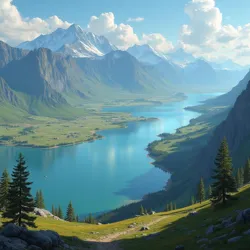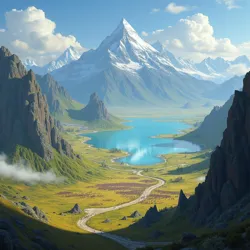Oleth
 A sweeping vista of the Olethian heartland, showcasing the crystal-clear waters of the inland sea and the fertile plains that surround it. The distant peaks of the Kragnir Mountains can be seen on the horizon.
A sweeping vista of the Olethian heartland, showcasing the crystal-clear waters of the inland sea and the fertile plains that surround it. The distant peaks of the Kragnir Mountains can be seen on the horizon.Oleth is a vast and diverse continent in the world of Carinor, bounded by formidable mountain ranges and seas that have shaped its geography, climate, and the civilizations that call it home. The continent spans from the frigid northern reaches near the Kragnir Mountains to the sun-baked southern coastline bordering the Meridian Sea, encompassing a wide range of climatic zones and ecological regions that have given rise to distinct cultures and societies.
Geography and Climate
The northern border of Oleth is defined by the imposing Kragnir Mountains, a rugged range characterized by snow-capped peaks, ancient glaciers, and deep valleys carved by millennia of ice movement. These mountains serve as a natural barrier between Oleth and the frozen wastes of Nordmark, creating a unique microclimate that supports vast tracts of coniferous forests known as the Evergreen Belt. The hardy people of the Kragnic Clans have adapted to life in these harsh conditions, developing a rich culture centered around survival and reverence for the mountains they call home.
To the east, the even more formidable Eldrida Mountains rise like a great wall, their peaks often disappearing into the clouds. This mountain range plays a crucial role in Oleth's climate patterns, creating a significant rain shadow effect that has given rise to the Eastern Steppes, a vast expanse of grasslands that stretch for hundreds of miles. The Eldrida range is home to the legendary Sky Kingdoms, where warrior societies have built impressive citadels into the mountainsides, and ancient Cloudwing Dragons still nest among the highest peaks.
 The remnants of the First Age civilization along the banks of the Lyra River, showing intricate stone architecture integrated with the natural landscape.
The remnants of the First Age civilization along the banks of the Lyra River, showing intricate stone architecture integrated with the natural landscape.The heart of Oleth is dominated by the Inland Sea, a vast body of water that moderates the climate of the surrounding regions and has historically served as the cradle of several major civilizations. Three major rivers - the Lyra, the Valtor, and the Tharros - feed into this sea, creating fertile valleys that have supported agriculture and urban development for millennia. The Lyran Valley Confederacy traces its origins to the first settlements along these waterways, and their architectural and cultural influences can still be seen throughout the region.
Cultural Regions
The diverse geography of Oleth has given rise to distinct cultural regions, each with its own traditions, governance systems, and relationships with neighboring areas. In the northern forests, the Silverpine Communes have developed a unique society based on sustainable forestry and ancient druidic traditions. Their careful stewardship of the forest resources has allowed them to maintain a delicate balance with the natural world for generations.
Along the eastern steppes, the nomadic Windrunner Tribes move with their herds according to ancient patterns, their movements dictated by the seasonal changes and the availability of grazing lands. These skilled horsemen have developed a complex social structure based on clan affiliations and have become legendary for their mastery of mounted archery.
The southern coastal regions, particularly around the Golden Bay, have evolved into a complex network of maritime city-states known as the Thalassocracy of the Seven Ports. These cities have grown wealthy through trade, diplomacy, and occasionally piracy, creating a unique culture that blends influences from both Oleth and the distant shores of Zahran.
Historical Development
The history of Oleth is marked by several distinct periods that have shaped its current political and cultural landscape. The First Age saw the rise of the great river civilizations, whose monumental architecture and sophisticated irrigation systems laid the groundwork for later societies. During the Age of Migration, peoples from across Carinor settled in various regions of Oleth, bringing with them diverse customs and technologies that enriched the continent's cultural tapestry.
The Second Age was characterized by the emergence of powerful city-states around the Inland Sea, leading to both cooperation and conflict as these urban centers competed for resources and influence. This period saw the development of advanced maritime technology, complex legal systems, and the establishment of the first inter-regional trade networks.
 A sacred gathering of the Windrunner Tribes during their annual migration, showing traditional ceremonial dress and customs passed down through generations.
A sacred gathering of the Windrunner Tribes during their annual migration, showing traditional ceremonial dress and customs passed down through generations.The current Third Age has been marked by increasing interaction between Oleth's various regions, facilitated by improved transportation networks and diplomatic initiatives. The establishment of the Grand Conclave, a regular gathering of representatives from all major Olethian powers, has helped maintain relative peace and prosperity across the continent, though tensions and rivalries persist beneath the surface.
Economy and Trade
The economic systems of Oleth are as varied as its landscapes, ranging from the sophisticated mercantile networks of the coastal cities to the traditional barter systems still practiced in some rural areas. The Inland Sea Trade Routes form the backbone of continental commerce, with merchant vessels carrying goods between the major ports of Lyrahaven, Valtor's Crown, and Tharrosport.
The northern regions are known for their timber exports and rare medicinal herbs, while the eastern steppes produce prized horses and textiles. The southern coastal regions have become centers of shipbuilding and maritime trade, with the Golden Bay serving as a crucial link between Oleth and the markets of Zahran.
Environmental Challenges
Despite its natural abundance, Oleth faces several environmental challenges. The Eastern Desertification threatens to expand the arid regions beyond their historical boundaries, while intensive agriculture in some river valleys has led to soil degradation. The Council of Wardens, an organization dedicated to environmental preservation, works to address these issues through a combination of traditional knowledge and innovative solutions.
The delicate balance between development and conservation remains a central concern for Oleth's leaders, particularly as population growth and technological advancement place increasing demands on natural resources. The success of initiatives like the Green Accord demonstrates the continent's commitment to sustainable development, though much work remains to be done.
Legacy and Future
Oleth's unique geography has created a tapestry of cultures and ecosystems that continue to evolve and adapt to changing circumstances. The continent stands as a testament to the resilience of its peoples and the enduring influence of its natural features on human civilization. As Oleth moves forward into an uncertain future, the wisdom accumulated over generations of living in harmony with its diverse landscapes may prove to be its greatest asset.
The ongoing efforts to preserve Oleth's natural and cultural heritage while embracing progress have made it a model for other regions of Carinor. The continent's story continues to unfold, shaped by the eternal dialogue between its peoples and the land they call home.